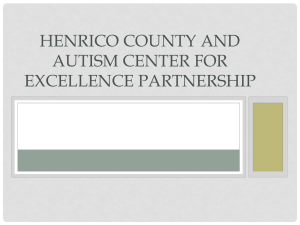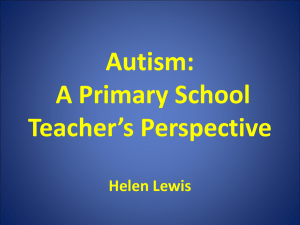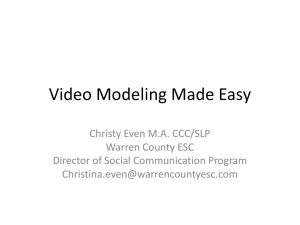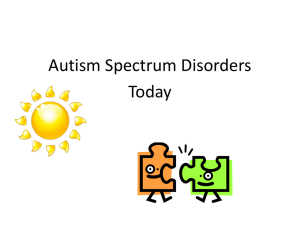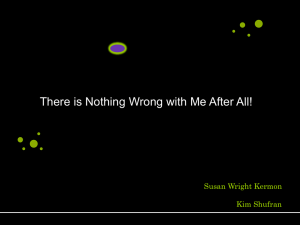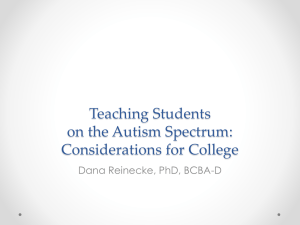103-Infants-and-Todd.. - Smart Start & The North Carolina
advertisement
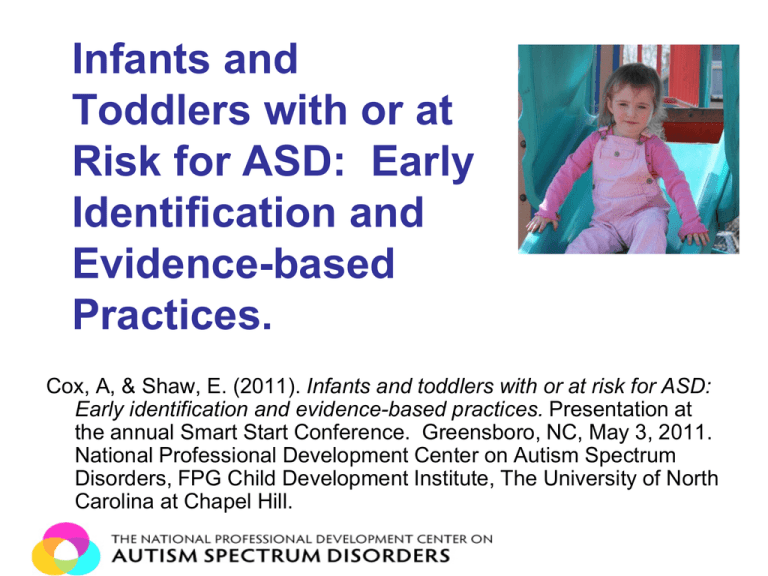
Infants and Toddlers with or at Risk for ASD: Early Identification and Evidence-based Practices. Cox, A, & Shaw, E. (2011). Infants and toddlers with or at risk for ASD: Early identification and evidence-based practices. Presentation at the annual Smart Start Conference. Greensboro, NC, May 3, 2011. National Professional Development Center on Autism Spectrum Disorders, FPG Child Development Institute, The University of North Carolina at Chapel Hill. National Professional Development Center on Autism Spectrum Disorders A multi-university center to promote use of evidencebased practice for children and adolescents with autism spectrum disorders FPG Child Development Institute, University of North Carolina at Chapel Hill; M.I.N.D. Institute, University of California at Davis Medical Center; Waisman Center, University of Wisconsin at Madison Goals of the National Center • Promote development, learning, and • • achievement of children with ASD and support families through use of evidence-based practices Increase state capacity to implement evidencebased practices Increase the number of highly qualified personnel serving children with ASD What do we do? Bridge the Gap Replicable practices in programs and classrooms Researchbased practices Topics of this Presentation • Characteristics of autism in infants and toddlers • Early screening and diagnosis • Evidence-based practices for toddlers with ASD Part I Characteristics of Autism in Infants and Toddlers Autism Spectrum Disorders • • • • Are developmental disorders Symptoms evolve and change with development “spectrum disorder” Consists of the following primary diagnoses: PDD-NOS Autism Asperger ‘s syndrome Core Triad of Characteristics • Impairments in Social Interaction • Impairments in Communication/Language • Restricted, Repetitive, and Stereotyped Patterns of Behavior, Interests, and Activities DSM-IV Symptoms of Autism • Qualitative impairment in social interaction decreased/absent nonverbal behaviors to regulate interactions lack of spontaneous sharing lack of social reciprocity failure to develop peer relations DSM-IV symptoms of autism • Qualitative impairments in communication delay in communication/speech development lack of appropriate imitative or pretend play lack of initiating and sustaining conversation stereotyped, repetitive language DSM-IV symptoms of autism • Repetitive, restricted patterns of behavior, interests, and activities preoccupation with parts of objects repetitive motor movements abnormally preoccupied with interests rigid adherence to nonfunctional rituals, routines rarely endorsed Not all DSM-IV criteria for autism applicable for young children (Stone 1999) How early do symptoms or characteristics of ASD emerge? Characteristic developmental problems in 24 month olds with ASD In virtually all children • Problems with imitation • Joint attention deficits • Receptive and expressive language delays and deviance • Immature functional and symbolic play • Lack of typical emotional expressiveness and communication Developmental problems in 18-24 month olds with ASD In many children • Increased repetitive behaviors • Increased parental reports of sensory • responsivity Sleep, eating, and behavior problems Imitation • Imitation Imitation is used by typically developing children to acquire communication, social, and motor skills Imitation skills of children with ASD tend to be poor Impairments in imitation often persist throughout life in individuals with ASD Problems imitating other people’s actions (Rogers et al., 2004) Autism specific problems with all types of imitation 8 7 6 5 * * autism DD typical 4 3 2 1 0 manual oral object Deficits in play • Symbolic play underdeveloped • Functional object use infrequent • Sensorimotor play – less novelty and more • repetition Fewer advanced play schemes Repetitive and Exploratory Play (Ozonoff et al., 2008) Atypical Uses of Objects •Spins (frequency) •Rolls (frequency) •Rotates (duration) •Unusual Visual (duration) 10 70 9 Frequency 7 6 Autism/ASD 5 Other Delays 4 No Concerns 3 2 Duration (seconds) 60 8 50 Autism/ASD 40 Other Delays 30 No Concerns 20 10 1 0 *** 0 Spins ** ** Rolls Rotates * * Unusual Visual *** Sample – 12 month olds, 9 ASD, 10 DD, 47 TYP Additional Learning Characteristics and Needs • Sensory issues: Heightened or decreased experience of sounds, lights, movement, touch, smell or taste, or fascination with sensory experiences Contribute to distractibility, difficulty in shifting attention May lead to avoidance behaviors May lead to sensory seeking behavior May impact learning, social interactions, behavior Sensory/repetitive behavior (Rogers et al 2003) Total sensory scores of 2 year olds on Dunn’s Sensory Profile 60 14 50 40 Total repetitive behavior scores on ADI * * * 12 10 8 30 * 6 20 4 10 2 0 autism FXS DD typical 0 ADI total autism FXS DD typical Developmental rates from 6-24 months: Language development 9 children with ASD; 27 with typical development p<.001 at all ages except 6 months 30 27 24 dev.age 21 ASD RL TYP RL TYP EL ASD EL 18 15 12 9 6 3 6 12 18 Months 24 Developmental rates from 6-24 months: Motor development 9 children with ASD; 27 with typical development p<.001 at all ages except 6 months 30 27 24 dev. age 21 ASD VR ASD FM TYP FM TYP VR 18 15 12 9 6 6 12 18 Months 24 Prototypic “early autism profile” 25 20 15 10 TYP AUT 5 0 TYP LANG SOC COG SC FM GM Prototype of 24 month old profile Take home messages • Onset of ASD symptoms more of a continuum • • • • than a dichotomy. Onset of ASD symptoms typically occurs between ages 1-3. Deceleration of development occurs in the majority of children. Different routes to full symptom expression may represent individual differences. Children on the spectrum have different early developmental characteristics than typically developing children. Part II: Early Screening and Diagnosis Value of Early Identification • Mean age of autism diagnosis • Years • = 34 – 61 months Mean age of first parental concern = 18 – 19 months Gap means 1-2 years before diagnosis made Treatment thus delayed Intensive early intervention = better outcomes Earlier identification earlier intervention • • Mandell et al., 2005 8 6 4 2 0 First concerns Autism Dx PDDNOS Dx n = 965 Asperger Dx What are the Red flags of ASD? Red flags of autism in infants Impairment in Social Interaction • Lack of appropriate eye gaze • Lack of warm, joyful expressions • Lack of sharing interest or enjoyment • Lack of response to name Impairment in Communication • Lack of showing gestures • Lack of coordination of nonverbal communication • Unusual prosody (little variation in pitch, odd intonation, irregular rhythm, unusual voice quality) Repetitive Behaviors and Restricted Interests • Repetitive movements with objects • Repetitive movements or posturing of body, arms, hands, fingers IDEA Early Identification Efforts Early ID is federally mandated through Part C of IDEA. Are the processes for early ID similarly mandated? No! There is currently no standard for ID of children under 2 years. There is no national data of number of infants/toddlers with or at risk for ASD. NECTAC/NPDC on ASD On Line Survey 2009 40 respondents in 30 states/jurisdictions scattered throughout the US and Pacific. Part C program = 18 Section 619 program = 13 Represented both programs = 9 Survey Question: Screening Which screening measures or tools are used to screen young children for ASD? States could select “all that applied” from a list of typically used measures. Screening Tools Screening tools most often used out of 10 screening tools identified. Most respondents indicated that more than one screening tool is being used (N=36, 90%). Measure States/Jurisdictions (N=40) % of Participating State/Jurisdictions ASQ-SE 33 83% MCHAT 29 73% CHAT 14 35% Survey Question: Diagnostic Procedures/Instruments Identify the instruments/procedures used to diagnose ASD in children under five years of age. States could select “all that applied” from a list of typically used instruments or procedures. Diagnostic Instruments/Procedures Most frequently identified diagnostic instrument/procedures used in states. Most respondents indicated that multiple measures were being used (N= 29, 81%) Measure States/Jurisdictions (N=36) % of Participating State/Jurisdictions CARS 25 69 % ADOS 22 61% DSM-IV 18 50% 3 8% No diagnoses made Current Trends: Age of Earliest Diagnosis 87.5% of Part C and Section 619 coordinators indicated a trend in diagnoses before age 3 <18 months = 3 (7.5%)* Between 18 and 23 months = 17 (42.5%) Between 24 and 35 months = 15 (37.5%) Between 36 and 47 months = 4 (10%)** Between 48 and 59 months = 1 (2.5%)*** *Part C only; ** 3 of 4 Section 619; *** Part C Stability of 18 month Diagnoses Stable when clinically referred and diagnosed by experts Stable following multiple stage screening and diagnosis (Cox et al., 1999) Validated diagnostic instruments: AOSI and Toddler ADOS (2011) are coming Conclusions Trend toward earlier ID. Two primary screening tools & diagnostic measures used most often. Majority of states use multiple tools and diagnostic measures. Use of multiple tools/procedures for screening & diagnosis of ASD may lead to inconsistencies within states. Conclusions No national data is collected on number of young children with ASD under the age of three. National data may under-represent number of 3-5 year olds with ASD due to states’ use of developmental delay category. National Efforts • Priority for multiple federal agencies (Health and • Human Services, the Centers for Disease Control (CDC) and the U.S. Department of Education). Since 2007, CDC, Maternal and Child Health and the Association of University Centers on Disabilities (AUCD) have convened states to improve Early ID: Act Early Regional Summits. http://www.aucd.org/template/page.cfm?id=547 National Early Identification Efforts Learn the Signs, Act Early – Centers for Disease Control, National Center on Birth Defects and Developmental Disabilities (http://www.cdc.gov/ncbddd/actearly/index.html) Free materials for multiple audiences Developmental Milestones Fact Sheets, interactive tools and videos Developmental Screening Fact Sheets Fact Sheets on ASD and other developmental disabilities Recommended Screening Approaches • Level 1: Screen for general developmental delays • Level 2: Screen all children for ASD and Identify (Chakrabarti et al., 2006) Rationale: tools are much better Most young children with ASD have delays American Academy of Pediatrics Recommends primary care providers should: Be aware of early signs of ASD; Ask all parents about developmental milestones and behavior at each visit; If concerns are identified by parents/professionals: Administer an autism-specific screener and/or refer child immediately for a diagnostic evaluation Screen all children, using an autism-specific screener, at 18 and 24 months of age. Modified Checklist for Autism in Toddlers M-CHAT – Robins, 1999 • • • • • • For 18 months and up Published and available online 23 yes/no parent questionnaire for ASD Built from CHAT items Screening positive for ASD = failing any 3 items, OR, failing 2 of 6 critical items For positive screens, failures are followed up with phone call M-CHAT Key Items Robins et al., 1999 2. Does your child take an interest in other children? 7. Does your child ever use his/her index finger to point, to indicate interest in something? 9. Does your child ever bring objects over to you (parent) to show you something? 13. Does your child imitate you? (e.g., you make a face-wil your child imitate it?) 14. Does your child respond to his/her name when you call? 15. If you point at a toy across the room, does your child look at it? Clinical Diagnosis of Autism Requires: • detailed history of early development, • parental descriptions of current behavior at home, • direct clinical interactions with child by experienced practitioner, and • follow up until 3 years. Screening must occur across the first five years Screen 18 months and yearly til 5 Re-assess at 36 and 60 mos at least Evaluate those who fail screens Provide intervention for atypical development Part III: Evidence-Based Practices (EBPs) for Toddlers with ASD What are EBPs? National Professional Development Center on ASD Focused interventions that: • Produce specific behavioral/developmental • • outcomes for a child Have been demonstrated as effective in applied research literature Can be successfully implemented in educational settings (Odom, Boyd, Hall, & Hume, 2009) What Counts As Evidence? 57 What Counts As Evidence? • Peer-reviewed, refereed journal articles • Report research Clearly identified children with ASD and/or families as participants High quality methodologies Experimental group designs Quasi experimental designs Single subject designs 58 National Professional Development Center on ASD • Began in 2007 to promote the use of evidence• • • based practices in programs for children and youth with ASD and their families. Had to identify evidence-based practices. Conducted literature review of focused interventions (as compared to comprehensive treatment models). Formulated a set of criteria for the type and amount of evidence needed to support efficacy. EBP for Learners Younger than 36 Months • Antecedent-based interventions • Differential reinforcement • Discrete trial training • Extinction • Functional behavior assessment • Functional communication training • Naturalistic interventions • Parent-implemented intervention • Peer-mediated instruction/intervention • Picture Exchange Communication System • Pivotal response training • Prompting • Reinforcement • • • • • Response interruption/redirection Self-management Social narratives Social skills training groups Speech generating devices • Structured work systems • Task analysis • Time delay • Video modeling • Visual supports Evidence-Based Practices Birth – 2 What We Know • Research literature involving infant and toddler • participants with ASD is limited but growing. Some defensible practices for early intervention: Parent-implemented interventions Naturalistic interventions employed in the home (milieu, activity-based, incidental) Current work on joint attention & prelinguistic communication Discrete trial training for older 2 year olds Evidence-Based Practices Birth– 2 What We Know • Focused interventions with promise Picture Exchange Communication System Pivotal Response Training Behavioral strategies: prompting, time delay, task analysis, reinforcement Practices used to decrease challenging behaviors: FBA, FCT, RIR, extinction Visual supports Structured work systems Boyd, Odom, Humphreys & Sam (2010) Summary • A few focused interventions for infants and • • toddlers with ASD have established efficacy through research. Some comprehensive treatment models exist; one has been shown to be efficacious through randomized control trial study (Early Start Denver Model). Toddler Treatment Network * – 8 projects focusing on infants/toddler intervention models underway. *Funded by Autism Speaks Conclusions • Intervention in the first three years of life may have powerfully positive effects for infants and toddlers with ASD. • A research literature on effective early intervention is emerging. • Practice may be guided by current emerging literature and existing research with preschool children with ASD. 64 Prompting • Prompting procedures include help given to learners to assist them in using a specific skill. • Prompting procedures that have been shown to be effective with learners with ASD include leastto-most-prompts, simultaneous prompting, and graduated guidance and can include verbal, gestural, and model prompts. Reinforcement • An association between learner behavior and a • • • consequence that follows the behavior. If a consequence increases the probability that a behavior will occur again, it can be said to be a reinforcer. Positive reinforcement involves offering incentives to reward behavior (token economy). Negative reinforcement involves removing an aversive stimulus to reward behavior so that learners will use the targeted skill or will not engage in interfering behaviors. Time Delay • Time delay focuses on fading the use of prompts • • during instructional activities. Progressive time delay involves gradually increase the waiting time between an instruction and any prompts that might be used to elicit a response. Constant time delay, a fixed amount of time is always used between the instruction and the prompt as learners become more proficient at using the new skill. Discrete Trial Training • Discrete trial training (DTT) is • • • a one-to-one instructional approach that teaches skills in a planned, controlled, systematic manner. used when a skill can be taught in small repeated steps. Each trial has a definite beginning and end. Antecedents and consequences are carefully planned and implemented. Positive praise and tangible rewards are used to reinforce desired skills or behaviors. Functional Communication Training (FCT) • FCT is a systematic practice to replace inappropriate • • or interfering behaviors serving a communicative function with more effective behaviors. The targeted behavior is analyzed to identify its communicative function using a functional behavior assessment (FBA). An alternative and appropriate communicative behavior is taught to replace the interfering behavior. Naturalistic Intervention • Naturalistic intervention is a collection of • practices including environmental arrangement, interaction techniques, and behavioral strategies that are used to promote appropriate communication and social skills. The practices encourage specific target behaviors based on learner’s interests and build more elaborate learner behaviors that are naturally reinforcing and appropriate to the interaction. Parent-Implemented Intervention • Parents are taught to provide individualized • intervention to their child to improve/increase a wide variety of skills and/or to reduce interfering behaviors. Parents learn to implement practices in their home and/or community through a structured parent training program. Picture Exchange Communication System (PECS) • PECS helps children communicate and promotes • speech development and production. There are six phases of PECS instruction, with each phase building on the previous. 1. Teaching the physically assisted exchange 2. Expanding spontaneity 3. Simultaneous discrimination of pictures 4. Building sentence structure 5. Responding to, “What do you want?” 6. Commenting in response to a question Pivotal Response Training (PRT) • Teaches children to respond to naturally occurring • • • learning opportunities and to seek out such opportunities. Builds on children’s initiative and their own interests. Particularly effective for developing communication, language, play, and social behaviors. Intervention enhances four pivotal learning variables: motivation, responsivity to multiple cues, social initiations, and self regulation. Visual Supports • Enable learners to independently track events • and activities. Include the use of pictures, written words, gestures, objects within the environment, arrangement of the environment or visual boundaries, schedules, maps, labels, organization systems, timelines, and scripts. EBP Learning Resources • Evidence-based practices briefs (available on NPDC website: http://autismpdc.fpg.unc.edu Overview of the practice Steps for Implementing practice Implementation Checklist Evidence-base for practice • Online modules on evidence-based practices (www.autisminternetmodules.org)


